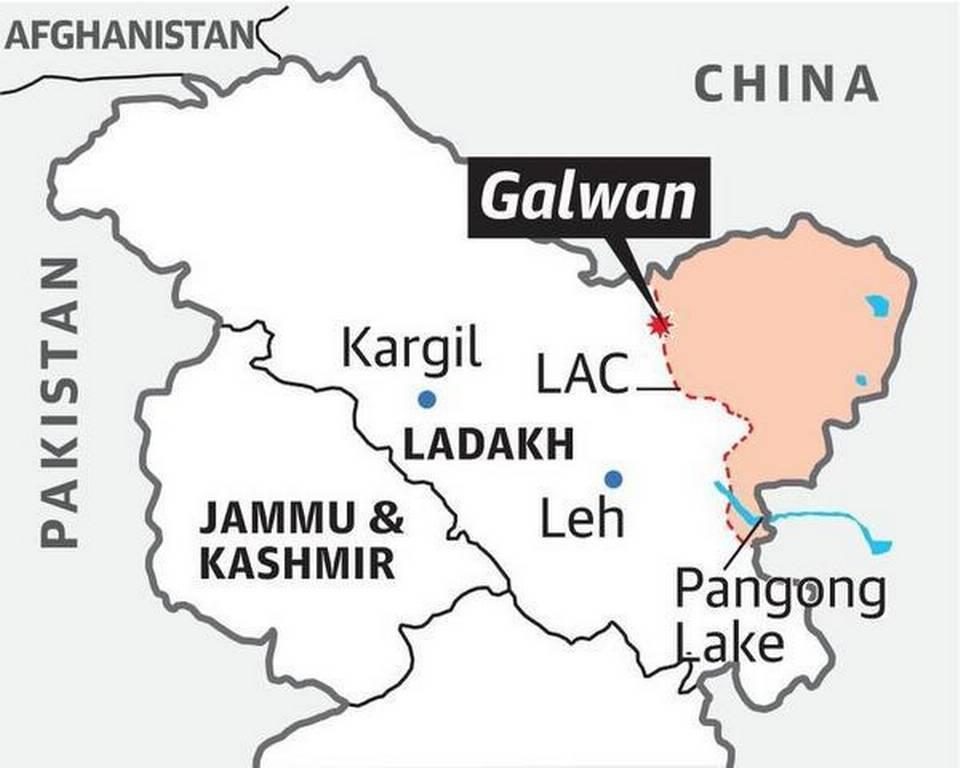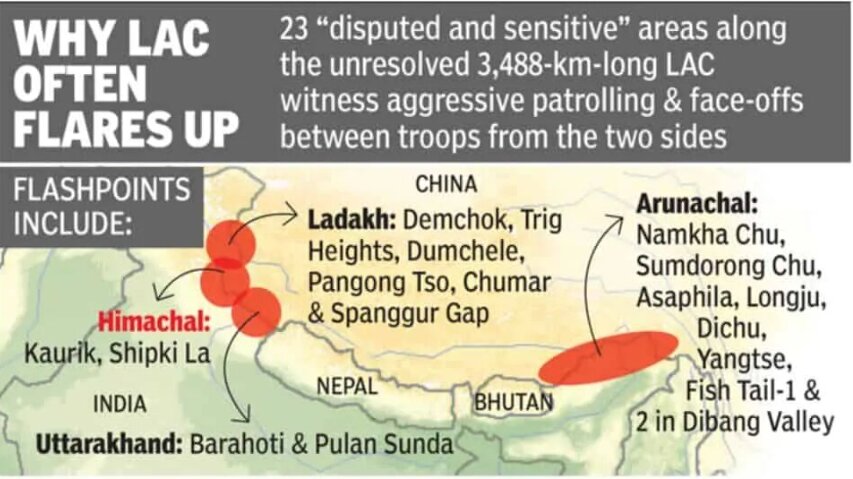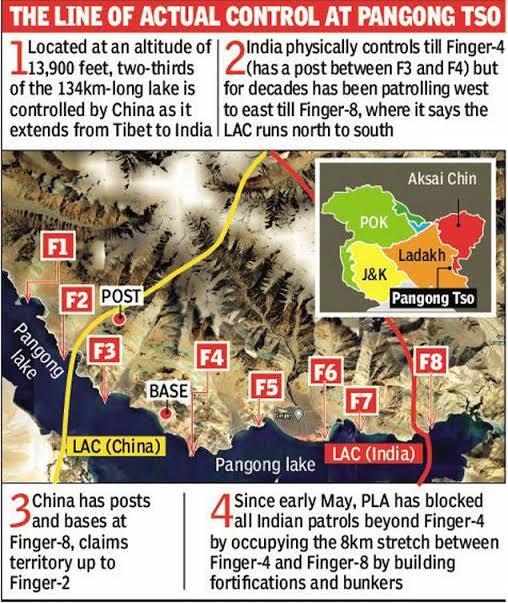International Relations
India-China Conflict
- 03 Jul 2020
- 10 min read
Why in News
Recently, the third round of Corps Commander-level talks was held between India and China.
- Both the sides emphasised on expeditious, phased and step-wise de-escalation in areas close to the Line of Actual Control (LAC) in Ladakh as priority.
Key Points
- Background:

- In the previous two rounds, India sought restoration of the status quo as it existed before the standoff began in May 2020.
- Indian and Chinese troops scuffled at Pangong Tso in Ladakh on 5/6th May.
- After the first round of talks on 6th June, 2020, clashes occurred in Galwan Valley (Ladakh) that claimed 20 Indian soldiers’ lives and an unknown number of casualties on the Chinese side.
- While faceoffs and standoffs keep occurring on the LAC due to differences in perception on the alignment, there has been no instance of firing on the LAC since 1975.
- India and China fought a war in 1962.
- In the previous two rounds, India sought restoration of the status quo as it existed before the standoff began in May 2020.
- India’s Response:
- Military:
- India has moved in additional divisions, tanks and artillery across the LAC to match Chinese deployments.
- Further, India has approved the purchase of 33 Russian fighter jets and upgrades to 59 war planes at a cost of Rs. 18,148 crore.
- Economic:
- Citing the “emergent nature of threats” from mobile applications, including popular ones of Chinese origin such as TikTok, ShareIt, UCBrowser, and Weibo, the government has banned 59 apps.
- Further, India’s trade deficit with China fell to $48.66 billion in 2019-20 on account of the decline in imports. The trade deficit stood at $53.56 billion in 2018-19 and $63 billion in 2017-18.
- However, the tensions on the border, as well as the Covid-19 pandemic, have thrown light on India’s economic dependencies on China.
- India remains reliant on Chinese products in several critical and strategically sensitive sectors, from semiconductors and active pharmaceutical ingredients to the telecom sector, where Chinese vendors are involved not only in India’s 4G network but in on-going 5G trials as well.
- Foreign Direct Investment (FDI) from China in India has dipped to $163.78 million in 2019-20 from $229 million in 2018-19.
- In April 2020, the Indian government tightened FDI norms coming from the countries which share land borders with India. Government approval has been made mandatory.
- Military:
- China’s Reaction:
- It has described the app ban action as “a deliberate interference in practical cooperation” between the two countries. China’s State media has warned of economic repercussions, such as affecting outbound Chinese investment into India.
Possible Reasons Behind Increased China’s Deployment at the LAC
- India’s decision to strengthen its border infrastructure (Darbuk-Shyok-Daulat Beg Oldie road).
- India’s United States tilt (e.g. Quad) amid US-China tensions.
- China views India’s assertions regarding Gilgit-Baltistan, as an implicit attack on the China-Pakistan Economic Corridor (CPEC), China’s flagship programme.
- China’s growing assertiveness over the South China Sea.
- Political and economic tensions within China due to Covid-19 pandemic.
- India being a growing power in Asian region.
Line of Actual Control
- Demarcation Line: The Line of Actual Control (LAC) is the demarcation that separates Indian-controlled territory from Chinese-controlled territory.
- LAC is different from the Line of Control (LoC) with Pakistan:
- The LoC emerged from the 1948 ceasefire line negotiated by the United Nations (UN) after the Kashmir War.
- It was designated as the LoC in 1972, following the Shimla Agreement between the two countries. It is delineated on a map signed by the Director General of Military Operations (DGMO) of both armies and has the international sanctity of a legal agreement.
- The LAC, in contrast, is only a concept – it is not agreed upon by the two countries, neither delineated on a map or demarcated on the ground.
- Length of the LAC: India considers the LAC to be 3,488 km long, while the Chinese consider it to be only around 2,000 km.
- Sectors Across the LAC:
- It is divided into three sectors: the eastern sector which spans Arunachal Pradesh and Sikkim (1346 km), the middle sector in Uttarakhand and Himachal Pradesh (545 km), and the western sector in Ladakh (1597 km).
- The alignment of the LAC in the eastern sector is along the 1914 McMahon Line.
- The McMohan line marked out previously unclaimed/undefined borders between Britain and Tibet.
- The middle sector is the least disputed sector, while the western sector witnesses the highest transgressions between the two sides.
- It is divided into three sectors: the eastern sector which spans Arunachal Pradesh and Sikkim (1346 km), the middle sector in Uttarakhand and Himachal Pradesh (545 km), and the western sector in Ladakh (1597 km).
- Disagreements:
- India's claim line is different from that of the LAC. It is the line seen in the official boundary marked on the maps as released by the Survey of India, including Aksai Chin (occupied by China).
- In China’s case, LAC corresponds mostly to its claim line, but in the eastern sector, it claims the entire Arunachal Pradesh as South Tibet.
- The claim lines come into question when a discussion on the final international boundaries takes place, and not when the conversation is about a working border i.e. LAC.
- Border Negotiations:
- Indian Prime Minister’s visit to China in 2003 led to the agreement on appointing Special Representatives (SRs) and, in April 2005, there was agreement on the political parameters and principles that would underpin negotiations.
- The aim was a comprehensive solution encompassing all three sectors. The agreed boundary would follow well-defined geographical features and respect the interests of the settled populations.
- During Indian Prime Minister’s visit to China in May 2015, the proposal to clarify the LAC was rejected by the Chinese.
- However, in the Wuhan (2018) and Mahabalipuram (2019) summits, both China and India had reaffirmed that they will make efforts to “ensure peace and tranquility in the border areas”.
- Indian Prime Minister’s visit to China in 2003 led to the agreement on appointing Special Representatives (SRs) and, in April 2005, there was agreement on the political parameters and principles that would underpin negotiations.
Relevance of Pangong Tso Lake
- Location: It is a long narrow, deep, endorheic (landlocked) lake situated at a height of more than 13,000 ft in the Ladakh Himalayas.
- Significance: It lies in the path of the Chushul approach, one of the main approaches that China can use for an offensive into Indian-held territory.
- Governance: It is overlooked by the Finger Area - a set of eight cliffs extending out of the Sirijap range (on the northern bank of Lake).
- India claims that the LAC is coterminous with Finger 8 but it physically controls area only upto Finger 4.
- Chinese border posts are at Finger 8, while it believes that the LAC passes through Finger 2.
Way Forward
- Detailed protocols are in place for troops to handle face-off incidents. The countries need to stick to the 2005 protocol and the 2013 Border Defence Cooperation Agreement.
- On 1st April, 2020, India and China completed their 70 years of diplomatic relations. Both sides should acknowledge that the situation is precarious, and that the recent days in particular have undone decades of painstakingly negotiated confidence-building mechanisms.
- For India, the first priority has to be to restore the status quo ante at the border as it existed in April. This will require both a display of military strength at the border by standing up to Chinese aggression, and diplomatic work by making it clear to China that its intervention will lead to heavy costs across all spheres of the relationship.
- India cannot afford to sever all its economic links with the world’s second-largest economy, even in the digital space. Chinese finance will help in sustaining India’s start-up economy. However, through Atmanirbhar Bharat Abhiyan, India can try to replace chinese products with domestic products in the sectors where it is possible. Further, it needs to boost up its economic relations with other countries.








